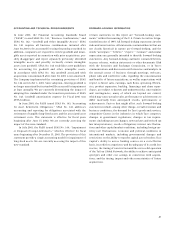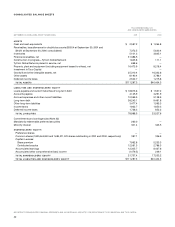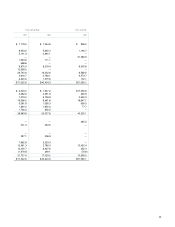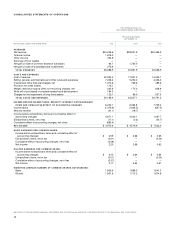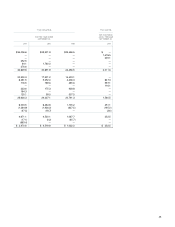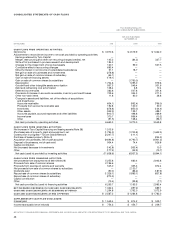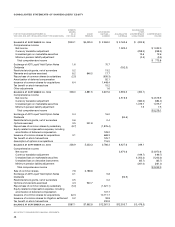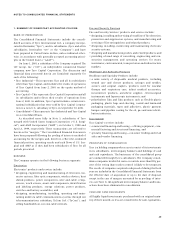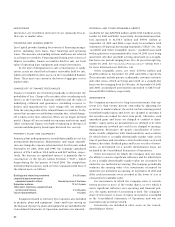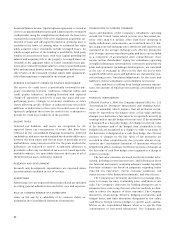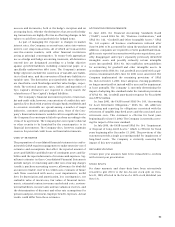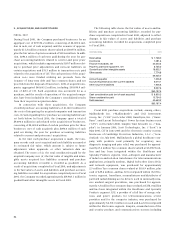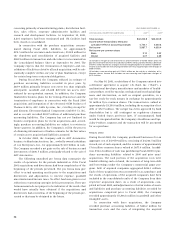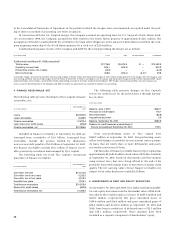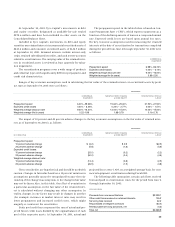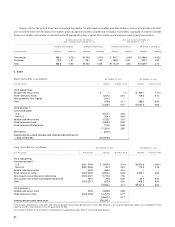ADT 2001 Annual Report Download - page 53
Download and view the complete annual report
Please find page 53 of the 2001 ADT annual report below. You can navigate through the pages in the report by either clicking on the pages listed below, or by using the keyword search tool below to find specific information within the annual report.
51
LONG-LIVED ASSETS
The Company periodically evaluates the net realizable value of
long-lived assets, including property, plant and equipment, rely-
ing on a number of factors including operating results, business
plans, economic projections and anticipated future cash flows.
An impairment in the carrying value of an asset is recognized
when the fair value of the asset is less than its carrying value.
IMPAIRED LOANS
Impaired loans include primarily large loans that are placed on
non-accrual status or any troubled debt restructuring. Loan
impairment is defined as any shortfall between the estimated
value and the recorded investment in the loan, with the esti-
mated value determined using the fair value of the collateral, if
the loan is collateral dependent, or the present value of expected
future cash flows discounted at the loan’s effective interest rate.
SECURITIZATIONS
Pools of assets are originated and sold to independent trusts
which, in turn, issue securities to investors backed by the asset
pools. Tyco Capital retains the servicing rights and participates
in certain cash flows from the pools. The present value of
expected net cash flows that exceeds the estimated cost of serv-
icing is recorded at the time of sale as a “retained interest.”
Tyco Capital’s retained interests in securitized assets are
included in other assets. Subsequent to the recording of retained
interests, Tyco Capital reviews such values on an asset by asset
basis at least as often as quarterly. Fair values of retained inter-
ests are calculated utilizing current and anticipated credit
losses, prepayment speeds and discount rates and are then com-
pared to the respective carrying values. Losses, representing the
excess of carrying value over estimated current fair market
value, are recorded as impairments and are recognized as a
charge to operations. Unrealized gains are not credited to cur-
rent earnings but are reflected in shareholders’ equity as part of
other comprehensive income.
SHARE PREMIUM AND CONTRIBUTED SURPLUS
In accordance with the Bermuda Companies Act of 1981, when
Tyco issues shares for cash at a premium to their par value, the
resulting premium is credited to a share premium account, a
non-distributable reserve. When Tyco issues shares in exchange
for shares of another company, the excess of the fair value of the
shares acquired over the par value of the shares issued by Tyco
is credited, where applicable, to contributed surplus, which is,
subject to certain conditions, a distributable reserve.
REVENUE RECOGNITION
In December 1999, the Securities and Exchange Commission
(“SEC”) issued Staff Accounting Bulletin No. 101 (“SAB 101”),
“Revenue Recognition in Financial Statements.” In SAB 101, the
SEC staff expressed its views regarding the appropriate recogni-
tion of revenue with respect to a variety of circumstances, some
of which are relevant to the Company. As required, the Company
adopted SAB 101 in the fourth quarter of Fiscal 2001 retroactive
to the beginning of the fiscal year and is now recognizing
revenues from the installation of security systems and defer-
ring the associated direct incremental costs over the estimated
customer lives.
Revenue from the sale of products is recognized according
to the terms of the sales arrangement, which is generally upon
shipment. Revenue from the sale of services is recognized as
services are rendered. Subscriber billings for services not yet
rendered are deferred and taken into income as earned, and the
deferred element is included in accrued expenses and other cur-
rent liabilities or other long-term liabilities, as appropriate.
Contract sales for the installation of fire protection systems,
underwater cable systems and other construction related pro-
jects are recorded on the percentage-of-completion method.
Profits recognized on contracts in process are based upon esti-
mated contract revenue and related cost to completion. Revi-
sions in cost estimates as contracts progress have the effect of
increasing or decreasing profits in the current period. Provisions
for anticipated losses are made in the period in which they first
become determinable.
At September 30, 2001, accounts receivable included
retainage provisions of $100.7 million, of which $73.7 million
remained unbilled. At September 30, 2000, accounts receivable
included retainage provisions of $58.6 million, of which
$2.0 million remained unbilled. These retention provisions
relate primarily to fire protection and electronics contracts and
become due upon contract completion and acceptance. Of the
balance of $100.7 million at September 30, 2001, $44.7 million is
expected to be collected during Fiscal 2002.
Finance income includes interest on loans, the accretion of
income on direct financing leases, and rents on operating leases.
Related origination and other nonrefundable fees and direct
origination costs are deferred and amortized as an adjustment
of finance income over the contractual life of the transactions.
Income on finance receivables other than leveraged leases is rec-
ognized on an accrual basis commencing in the month of origi-
nation using methods that generally approximate the interest
method. Leveraged lease income is recognized on a basis calcu-
lated to achieve a constant after-tax rate of return for periods in
which Tyco Capital has a positive investment in the transaction,
net of related deferred tax liabilities. Rental income on operat-
ing leases is recognized on an accrual basis.
The accrual of finance income on commercial and consumer
finance receivables is generally suspended and an account is
placed on non-accrual status when payment of principal or
interest is contractually delinquent for 90 days or more, or ear-
lier when, in the opinion of management, full collection of all
principal and interest due is doubtful.
LEASE FINANCING
Direct financing leases are recorded at the aggregate future
minimum lease payments plus estimated residual values less


